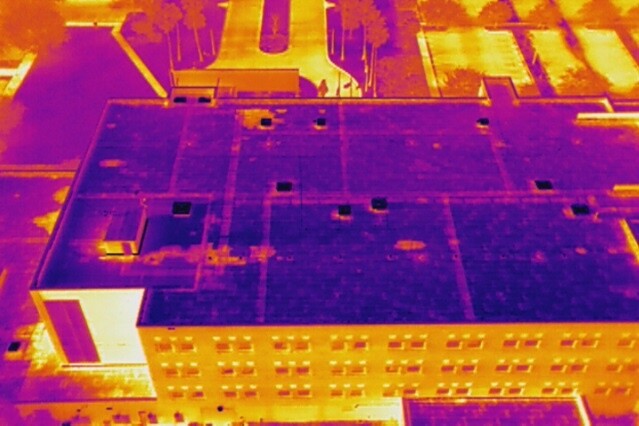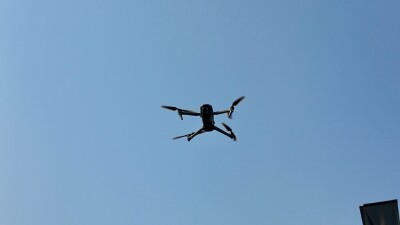For years, roofing professionals have been forced to spend hours on hot and dirty surfaces to do initial inspections of large, flat commercial and industrial roofs. The process is time-consuming, expensive—and potentially dangerous.
Using drones, however, can make inspections faster, safer, and more cost-efficient. And, when drones are equipped with thermal imaging cameras, inspections become even quicker, as well as less risky and more accurate.
Thermal imaging cameras allow inspectors to see infrared energy that is usually invisible to the naked eye. Advanced dual thermal camera payloads present even greater advantages. Dual thermal camera payloads, such as Teledyne FLIR’s VUE® TZ20-R, allow operators to zoom into subjects without loss of resolution. With these systems, operators can perform rapid moisture inspections, detailed examinations of roof-mounted mechanical systems, and much more.
Central to this technology is the use of two cameras. Dual thermal camera payloads for drones pair a wide field of view (FOV) thermal camera with another, narrower FOV thermal camera. By using two cameras, operators can utilize 5x optical zoom without affecting resolution and image quality. This improves the efficiency of thermal drone inspection, increases the speed of inspections, and cuts down on flight times.
Radiometry is another important feature of some dual thermal camera payloads. Cameras with radiometry can measure surface temperature to determine if glowing spots or cool areas on a roof are signs of a problem. Systems like the VUE TZ20-R—which provides accurate radiometry over a wide variety of environmental conditions—are ideal for complete, accurate roof inspections. Thermal cameras without radiometry simply aren’t very helpful.
Given these features, dual thermal camera payloads are great for assessing the condition of large commercial and industrial roofs, but they also help inspectors review the condition of the many mechanical systems often found on these surfaces. Thermal imaging can measure the temperature of generators, HVAC systems, air handlers, duct work, access points, and even solar panels. In addition, they can point out insulation and moisture issues that can impact the integrity of roofs. Accurate temperature and moisture readings can help operators identify potential problems and reduce false positives.
Clearly, dual thermal camera payloads provide significant advantages over previous inspection systems. But, despite the tremendous capabilities of the technology, operators must pay close attention to a number of environmental factors and develop clear plans to get the most out of their inspections.
By working closely with our clients, Teledyne FLIR has learned many lessons on how to optimize dual thermal camera payload roof inspection operations. Here are a few tips:
Time of day matters - To fly an effective thermal drone roof inspection, do not fly when there is a “solar load” on the roof. That is, do not conduct your operation during a time of full sun, when high temperatures on the roof could impact your camera readings. Instead, wait until the roof is in shadow or when the sun has set below the roof line. Then, get the shots you need quickly.
Weather and atmosphere can also affect your flight and data - There are a few optimal times and conditions for conducting your dual thermal camera payload inspection—and a few conditions to avoid:
- The best time to fly is about one hour after sunset (if allowed in your area).
- Light cloud cover can help you get an accurate reading on a roof.
- Fog can affect the how close you need to be to a roof to get an accurate reading.
- Rain can make a scene “isothermal,” meaning that the temperature remains constant. Isothermal conditions can hide problems. Be sure to perform an inspection a few hours after rain ends. This can be helpful as the drying process can highlight problem areas.
- Humidity can affect your data. For example, on a very warm and humid day, a 100-meter air path (35°C air temperature, 80% RH) has a theoretical transmission of 80%. That means that only 80% of the thermal radiative heat emitted from surface will reach the camera. If possible, conduct your inspections when there is relatively low humidity.
Consider flight parameters - How you fly the roof inspection can have a tremendous impact on the results you’ll achieve. Many flight factors can affect the quality of your images, including:
- Height: While you may want to see a full roof from high above, you may be giving up the accuracy you need to find defects.
- Look-down angle: If you are taking radiometric temperature measurements, avoid straight-on measurements. This will reduce direct camera reflection and avoid oblique angles to reduce overall reflection.
- Speed: To determine appropriate drone speed, find a balance between the amount of area you need to cover and the level of detail you need. In general, fly closer to the roof surface and slower to gather more data.
- Obstacles: Look out for obstacles by using your visual observer. Also, plan the flight ahead of time, taking note of obvious obstacles so your visual observer can call them out when you are flying in a hazardous location.
Set a baseline survey - While ideal for surveying for roof damage, thermal cameras are also perfect for conducting baseline surveys. As baseline survey provides information about the initial condition of the roof and allows you to determine if damage is developing over time. The best time to set a baseline survey is when a building has just been built or acquired.
About the Author Kelly Brodbeck is a Product Management Executive with Teledyne FLIR. He has experience in multiple technical industries including thermal imaging, photonics, energy development and operations, and medical devices. In his current role, he is charged with advancing Teledyne FLIRs commercial UAS product offerings to serve a broader portion of the market with new payloads, airframes, and software. Brodbeck holds a bachelor’s degree in chemical engineering from the University of California, Berkeley, and a Master of Science degree in chemical engineering from University of California, Santa Barbara.
Kelly Brodbeck is a Product Management Executive with Teledyne FLIR. He has experience in multiple technical industries including thermal imaging, photonics, energy development and operations, and medical devices. In his current role, he is charged with advancing Teledyne FLIRs commercial UAS product offerings to serve a broader portion of the market with new payloads, airframes, and software. Brodbeck holds a bachelor’s degree in chemical engineering from the University of California, Berkeley, and a Master of Science degree in chemical engineering from University of California, Santa Barbara.
















Comments